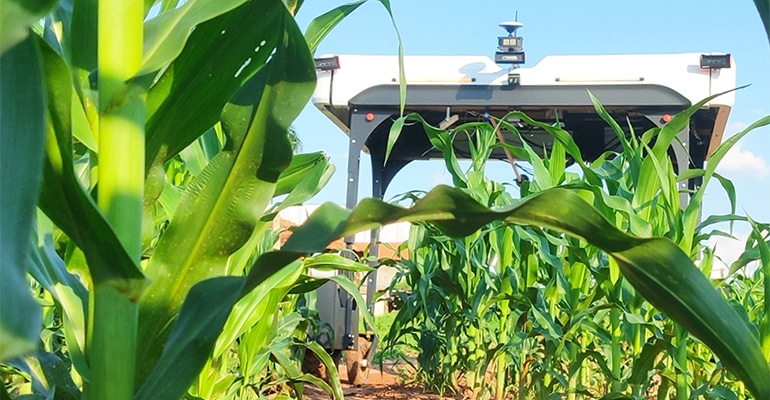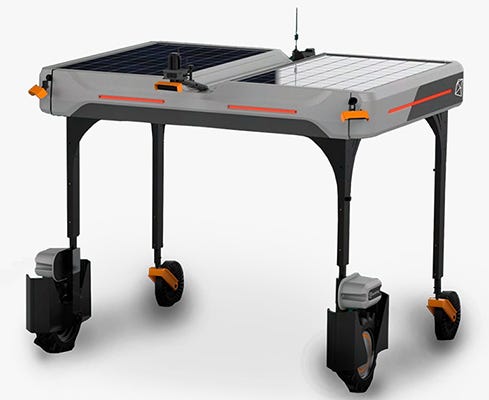
If you’re driving down a country road this spring and spy a glorified card table roving through a corn field, have no fear – the aliens have not invaded. The solar-powered autonomous robot you see is monitoring the crop to help ag retailers make fertilizer and weed control applications timelier and more efficient.
The robot is part of a partnership between cooperative Growmark and new-to-North America tech company Solinftec. And unlike typical tech scouting efforts that use satellite or drone imagery, Growmark and Solinftec are betting that this grounded approach is better.
“We want to monitor the crop below the canopy,” says Solinftec Chief Operating Officer for North America Daniel Padrão. “That differentiates us from other technologies. When you have satellites or drones you have to process the results, and it doesn’t always allow you time to act. Here we are watching that field and if we realize something is happening, we are going to trigger an action and then measure the quality of that action.”
The roving robot scans the field 24/7, sending data to ALICE, Solinftec’s cloud-based digital platform. ALICE is a “data science assistant” designed to integrate and process data from machinery, people, climate and external inputs; it calculates producers’ ultimate objectives and delivers real-time actionable recommendations to retailers working with farmer customers.
“We’re testing it this spring and will roll it out commercially in 2023,” adds Padrão. “We start with emergence, measure stand count, weed pressure, check weather, and all that triggers an ag retailer application. Knowing the weed pressure, we can better target the spray, and then after the spraying application we measure if we managed to kill all the weeds.”

While the bots don’t take soil samples, their cameras on top and below the canopy will measure weed control until the canopy closes. Cameras will also check for insect infestation.
Solinftec may sound new to Corn Belt farmers but the company has been in Mato Grosso, Brazil, and other regions since 2007. Its North American headquarters is in West Lafayette, Ind. Padrão, a former Brazilian farm manager, helped develop an AI-based program to reduce paperwork and make decisions based on real-time data. “I am employee number one in North America,” he quips.
Faster decisions
According to Growmark Agronomy and Tech director Lance Ruppert, retailers face two big challenges: increased farm size, and tighter planting windows as farmers seek to plant both corn and soybeans sometimes simultaneously. That has led to a retailer time crunch.
“There’s a lot of pressure and speed coming into the growing season,” says Ruppert. “There’s a condensed window of time now and it’s further impacted by erratic weather from climate change."
“In the past, we’ve taken care of customer needs through size and scale, but that only gets you so far today. That’s why data is critical,” he continues. “We need to do a good job planning on the front end, but also, to understand what products are tight on inventory that allow us to make instant in-season decisions that supply growers with what they need."
“We’re getting better at data, but we’re not there yet. Data helps us understand what growers need and when they need it.”
Padrão agrees. “We spend a lot of time on weed control and fertilizer prescriptions, and we spend a lot of time making machines more efficient to cover more ground, but there’s a gap between those two things,” he says. “Today’s machines are so big and prescriptions so precise, it’s impossible to deliver precision accurately, or it’s too expensive, or you have to wait for the right weather. So how can we intervene in that ecosystem that will allow us to make the best of the inputs we have, to get higher yields and less environmental impact? The goal is to use the infrastructure we have, in terms of equipment, to be sure we’re applying it the right way."
“Ag retailers can do this but it’s hard,” he adds. “They have to manage the whole fleet and manage weather. With ALICE we generate an algorithm that factors in the task, the product label, the fleet, planting dates, weather – and generates a plan. You press a button, the plan goes to the machine, and the driver takes the rig turn by turn to the right field. When they get there, they get real-time information about what to spray and how to spray."
“We have this digital platform, but we were missing some information to be able to trigger the services,” concludes Padrão. “That’s where the robot comes in. It was the missing link.”
Watch the robot in action:
About the Author(s)
You May Also Like






